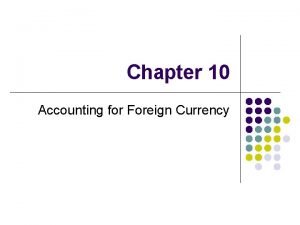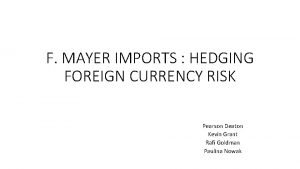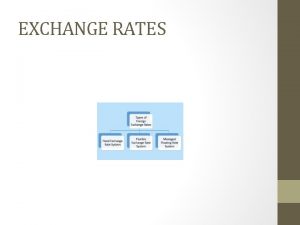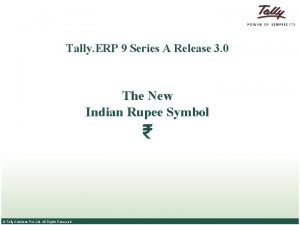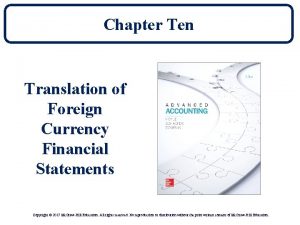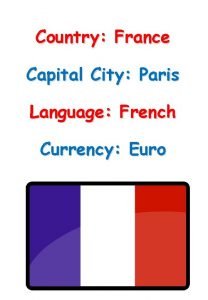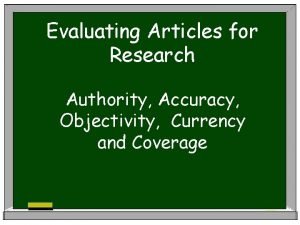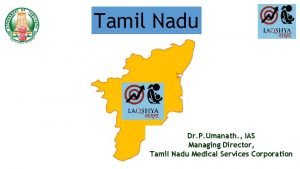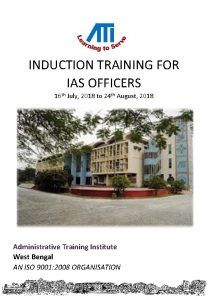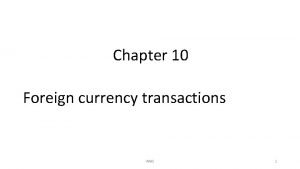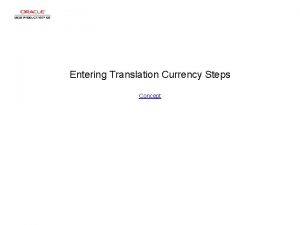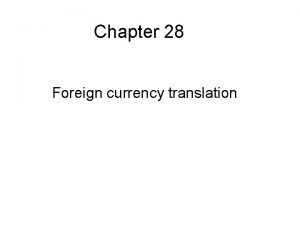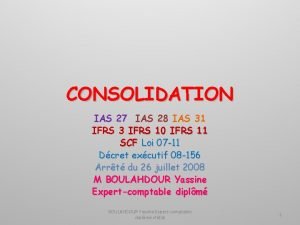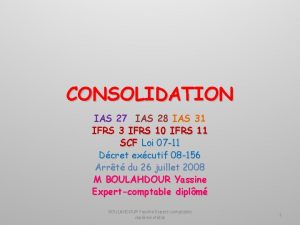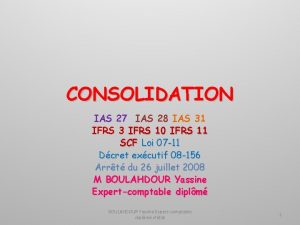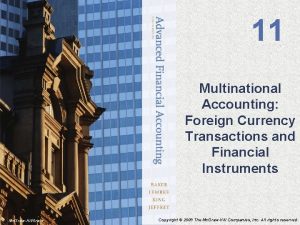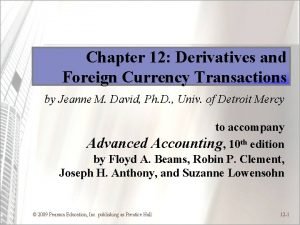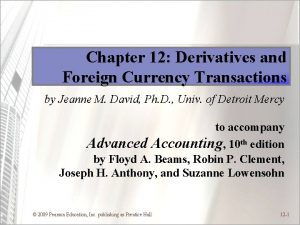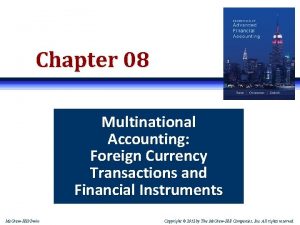IAS 21 FOREIGN CURRENCY TRANSACTIONS AND TRANSLATION OF























- Slides: 23

IAS 21 FOREIGN CURRENCY TRANSACTIONS AND TRANSLATION OF FOREIGN OPERATIONS

INTRODUCTION • • • Exchange rates affect competitiveness • Businesses that deal in a foreign currency are exposed to risks • IAS 21 The Effects of Changes in Foreign Exchange Rates A strong / weak currency impacts on exports and imports There is arguably no one best position – it depends on the nature of your business

IAS 21 The Effects of Changes in Foreign Exchange Rates Objective and Scope • To set down the manner in which foreign currency transactions should be brought to account • To set down the manner in which the financial statements of foreign operations should be translated for inclusion in the enterprise’s financial statements by consolidation, proportionate consolidation or by the equity method

IAS 21 – Objective and Scope • • Entity financial statements are sensitive to changes in foreign exchange rates Three factors, which stem from the entity’s underlying business model and business environment 1. Foreign transactions (e. g. , buying or selling in other countries) 2. Foreign operations (e. g. , operating a business in other countries) 3. Presentation currency (e. g. , presenting financial statements in another currency) 1. Transactions – – – 4 Many entities enter into transactions denominated in other currencies as part of their normal day-to-day business activities Any contract that is entered into, which is denominated in another currency and/or requires settlement in another currency, will be affected by changes in exchange rates Examples include foreign purchases and borrowing/lending in another currency

IAS 21 – Objective and Scope 2. Operations – – • Entities may also own businesses that are located in different countries Advantages may include tax incentives, access to raw materials, etc. Foreign operation – An entity that is a subsidiary, associate, joint venture, or branch of a reporting entity, the activities of which are based or conducted in a country or currency other than those of the reporting entity 3. Presentation of financial statements – An entity may choose to present its financial statements in a foreign currency – An entity may do this because it accesses capital markets in another country • 5 need to make the statements more comparable and understandable to local users

Key definitions • • • Functional Currency The currency of the primary economic environment in which the enterprise operates. Presentation Currency The currency in which an enterprise presents its financial statements. Closing Rate This is the spot exchange rate at the reporting date. Exchange Difference This is the difference resulting from translating one currency into another currency at different exchange rates. Monetary and Non Monetary Items Monetary items are assets/liabilities held to be received/paid in fixed or determinable amounts. Examples include deferred tax, pensions and provisions. The feature of a non-monetary item is the absence of a right to receive a fixed or determinable amount of money (this includes prepayments, goodwill, intangible assets, inventory and property).

Foreign Currency Transactions • Initial Recognition Ø Each transaction should be translated using the ER on the date the transaction occurred, or if stable, an average rate Ø If certain transactions are to be settled at a specified rate, or are covered by a matching forward contract, then use ‘contracted rate’ • Reporting at Subsequent Reporting Dates Ø Monetary items at closing ER (e. g. trade receivables and payables) Ø Non-monetary items measured at HC are not re-translated at the reporting date (e. g. non-current assets and inventory) Ø Non-monetary items measured at foreign currency fair value are re-translated at each date of fair value measurement

Recognition of exchange differences • • Those arising on settlement of monetary items should be expensed in the period they arise Where a gain/loss on a non-monetary item is recognised directly in equity any exchange component of that gain/loss should be recognised directly in equity Conversely when a gain/loss on a non-monetary item is recognised in profit or loss, any exchange component of that gain/loss should be recognised in profit or loss. If a transaction is settled before the end of a reporting, then: (i) record the foreign currency transaction in the functional currency at the spot exchange rate at the date of the transaction (an average rate for a period may be used if exchange rates do not fluctuate significantly); (ii) record the settlement at the exchange rate at the date of settlement; (iii) recognize the exchange difference (i. e. (i) minus (ii) in arriving at operating profit in the statement of comprehensive income).

Example: Transactions settled at the reporting date Blue Limited, whose year end is 31 December, buys goods from a foreign company for 180, 000 Ricos on 31 July 2013. The transaction is settled on 31 October 2013. Exchange rates: 31 July 2013 br 1 = 1. 5 Ricos 31 October 2013 br 1 = 1. 6 Ricos Requirement Show the journal entries to record the above transaction.

Example: Transactions settled at the reporting date Initial recognition: Dr SPLOCI – P/L – purchases Cr SFP – trade payables br 120, 000 Being initial recognition of goods purchased on credit (180, 000 Ricos / 1. 5) At settlement: Dr SFP – trade Payables Cr SPLOCI – P/L – Fx Gain Cr SFP – Cash br 120, 000 Being settlement and recognition of exchange difference br 7, 500 br 112, 500

Transactions not settled at the reporting date If a transaction is not settled before the end of a reporting, then: (i) record the transaction (in the functional currency) at the spot exchange rate at the date of the transaction; (ii) retranslate any monetary items; (iii) recognize any exchange difference in arriving at profit or loss in SPLOCI.

Example: Transactions not settled at the reporting date Top Limited buys goods from a foreign company for 500, 000 Zicos on 31 October 2012. The transaction was not settled at 31 December 2012, the company’s year end. Exchange rates: 31 October 2012 br 1 = 1. 6 Zicos 31 December 2012 br 1 = 1. 75 Zicos Requirement Show the journal entries to record the above transaction.

Example: Transactions not settled at the reporting date Initial recognition: Dr SPLOCI – P/L – purchases Cr SFP – trade payables br 312, 500 Being initial recognition of goods purchased on credit (500, 000 Zicos / 1. 6) At the reporting date: Dr SFP – trade payables Cr SPLOCI – P/L – Fx Gain br 26, 786 Being translation of payable at reporting date and recognition of exchange difference

Example: Purchase of a non-monetary item A company purchased a property on 1 January 2013 for 20, 000 DM (when br 1 = 4 DM), with the account being settled on 1 March 2013 when the exchange rate was 20, 000 DM = br 5, 500. If the company’s year end is after 1 March 2013, then this transaction should be recorded as follows: At 1 January 2013: Dr SFP – property Cr SFP – payables br 5, 000 Being initial recognition of property At 1 March 2013: Dr SPLOCI – P/L – Fx Loss br 500 Dr SFP – payables br 5, 000 Cr Bank br 5, 500 Being settlement of liability and recognition of exchange difference

Example: Purchase of a non-monetary item However, if the company’s year end is 31 January 2013, and at 31 January 2013 20, 000 DM = br 4, 900, then: At 31 January 2013: Dr SFP – payables Cr SPLOCI – P/L – exchange gain 31 January 2013: Dr SFP – payables Dr SPLOCI – P/L - exchange loss Cr SFP – bank br 100 br 4, 900 br 600 br 5, 500

FOREIGN CURRENCY TRANSLATION • • • Should follow normal consolidation procedures IAS 27 permits the use of different reporting dates as long as they are no more than three months apart and adjustments are made for the effects of any significant transactions between those dates. In such cases, the exchange rate to adopt is that at the reporting date of the foreign operation. IAS 21 shows how to translate FS into a presentation currency (i. e. the currency in which the FS are presented. This contrasts with the functional currency, which is the currency of the primary economic environment in which the (foreign) entity operates. Depending upon the relationship between the parent and the subsidiary companies, the presentation currency and the functional currency may or may not be the same.

Normal consolidation procedures • • • Eliminate IC balances Need to translate I/C monetary balances Goodwill treated as asset of foreign operation and translated at CR

Presentation currency ≠ Functional currency The translation mechanics are: • Assets & liabilities translated at the year-end rate (i. e. CR) • Exchange differences taken directly to reserves (separate component) • SPLOCI translated using AR • Exchange difference will arise from: Ø Retranslating the opening NA at CR Ø Translating SPLOCI at AR and SFP at CR

Foreign exchange differences Presentation Currency = Functional Currency: • Exchange differences should be recognised in the SPLOCI – P/L. Presentation Currency ≠ Functional Currency (Presentation Currency Method): • All exchange differences should be recognised in equity as a separate component (through OCI). Foreign exchange differences arise from: 1. Translating income and expenses at the transaction rate and assets/liabilities at the CR; 2. Translating opening net assets at an exchange rate different from that previously reported; 3. As any goodwill and fair value adjustments should be treated as assets and liabilities of the foreign operation, they therefore must be expressed in the functional currency of the foreign operation and translated at the CR. If a foreign operation is not 100% owned by the parent company, then exchange differences should be allocated to NCI.

Disposal of foreign entity Cumulative exchange differences should be recognised as income or expenses in the same period as the gain or loss on disposal is recognised

Disclosure 1. The amount of exchange differences included in arriving at profit or loss in the SPLOCI except those arising from IAS 39; 2. Net exchange differences classified as a component of equity and a reconciliation of opening and closing equity at start and end of the year; 3. When the presentation currency is different from the functional currency, that fact should be disclosed as well as disclosure of the functional currency and the reason for using a different presentation currency; 4. When there is a change in the functional currency of either the reporting entity or a significant foreign operation, that fact and reason for the change should be disclosed; 5. When an entity presents its financial statements in a currency different from its functional currency, it should describe the statements as complying with IFRSs only if they comply with all of the requirements of each applicable standard and SIC. Where the requirements listed at item 5. above are not met an entity should: • clearly identify the information as supplementary; • disclose the currency in which the supplementary information is displayed; • disclose the entity’s functional currency and method of translation used to determine the supplementary information.

FUNCTIONAL CURRENCY # PRESENTATION CURRENCY Quickbuck Limited 1. SPLOCI TRANSLATED USING AR Revenue Cost of sales $ ER € 544, 275 4 136, 069 (145, 000) 4 (36, 250) Gross profit 399, 275 Depreciation (30, 000) 4 (7, 500) (271, 050) 4 (67, 762) Other expenses PBT Income tax expense PAT OCI: FX losses 99, 819 98, 225 (24, 275) 24, 557 4 73, 950 (6, 069) 18, 488 (W 5(b)) (3, 198) 15, 290

2. A & L TRANSLATED USING CR 3. OSC TRANSLATED USING HR 4. RE AS BALANCING FIGURE PPE $ ER € 270, 000 5 54, 000 Inventory 48, 525 5 9, 705 Receivables 45, 500 5 9, 100 9, 475 5 1, 895 Bank and cash 373, 500 74, 700 Ordinary share capital 75, 000 3 25, 000 RE & FC translation reserve (should be shown separately) 70, 450 Balance (W 6) 4, 090 Loan 90, 000 5 18, 000 Payables 103, 775 5 20, 755 Taxation 24, 275 5 4, 855 Proposed dividends 10, 000 5 2, 000 373, 500 74, 700
 Financial statements translation
Financial statements translation Foreign currency accounting
Foreign currency accounting F mayer imports
F mayer imports Exchnage rate
Exchnage rate Www tallysolutions com
Www tallysolutions com Too foreign for home too foreign for here
Too foreign for home too foreign for here Asc 830
Asc 830 Semantic vs communicative translation
Semantic vs communicative translation Linear function transformations
Linear function transformations Voice translation rules
Voice translation rules 10 noun phrases
10 noun phrases Ias 16
Ias 16 Italy capital and currency
Italy capital and currency Capital city of paris
Capital city of paris Appreciation and depreciation of currency
Appreciation and depreciation of currency Currency news value example
Currency news value example Currency and timeliness
Currency and timeliness Authority accuracy objectivity currency and coverage
Authority accuracy objectivity currency and coverage Currency futures
Currency futures Country location decision
Country location decision Submitted by and submitted to example
Submitted by and submitted to example Dr umanath ias
Dr umanath ias Dr sanjay dubey indore
Dr sanjay dubey indore Alankrita singh ips
Alankrita singh ips

